Disclaimer: This post contains affiliate links to handpicked partners, including tours, gear and booking sites. If you click through or buy something via one of them, I may receive a small commission. This is at no extra cost to you and allows this site to keep running.
A guide to everything you need to know to complete the Lost City Trek in Colombia and how to get to the Ciudad Perdida archaeological site.
La Ciudad Perdida (Spanish for ‘Lost City’) is an ancient archaeological site perched within northern Colombia’s Sierra Nevada mountain region, built by the Tayrona people and dating to approximately 800 AD – older than Machu Picchu.
Long forgotten, nature covered it for centuries, but with the help of archaeologists and the blessing of local indigenous people who today protect their ancestral site, around 10% of it has been uncovered and made open for those who make the pilgrimage here on the Lost City trek.
The Lost City trek in Colombia was a journey that took me from the urban pockets of the Caribbean coastline to the isolated jungle basin that wraps around the highest coastal mountain in the world at 5,778 metres above sea level.
Getting there was an expedition into the world’s second-largest biodiversity system and a passage through the heartland of Colombia’s oldest indigenous communities.
One-third of the 30,000 square kilometres of the UNESCO reserved biosphere of Sierra Nevada de Santa Marta is a National Park open for exploration, where a path has been roughly carved through the wilderness to lead you to a hidden city and the central axis of a lost civilisation.

A Guide to The Ciudad Perdida Lost City Trek in Colombia.
This rich environment is also home to some of the best-preserved cultures in America, isolated and unseen until the second half of the 20th century. The Kogui, Wiwa, Arhuaco and Kankuamo communities are descendants of the Tayrona (Tairona) people of la Ciudad Perdida (Lost City), and have been living here for centuries and now maintain it.
You are simply a visitor walking amongst them on their land throughout the trek days.

The journey to the Lost City Colombia in the heart of indigenous Sierra Nevada de Santa Marta.
Trekking tourism in Colombia is a new lifeline to a region once rendered completely off-limits. After decades of violence during the violent years of illegal cocaine trafficking and from looters who discovered the Lost City in the 1970s, the region was reclaimed and declared an indigenous reserve in 1984, where life tries to return as normal.
It’s precisely this isolation and intrigue that brings in the more curious of travellers wanting to embark on the Ciudad Perdida trek. To find the Lost City.
However hard it is to get there.
In the words of my indigenous Wiwa guide, Gabo: “The hard things should be done, and the impossible should be tried.”
We certainly did, on arguably one of South America’s best treks.
Contents
- History of the Lost City of Colombia
- How Long is the Trek to the Lost City?
- Ciudad Perdida Tours
- How Much Does it Cost to Do the Lost City Trek?
- Best Time to Trek in the Lost City
- Lost City Trekking Route – Snapshot
- Is the Lost City Trek Difficult?
- Do I Need to Train for Lost City Trekking?
- What to Pack for Lost City Trekking
- Lost City Trek Day-by-Day
- Is The Lost City Trek Worth It?
History of the Lost City of Colombia
Hiking in Colombia and getting to the Lost City of Teyuna is an unparalleled experience. Much of what the site was and why it was there is still being unravelled.
There had always been stories of the lost cities of the Tayrona people of the Sierra Nevada – a remote region that remained unexplored for centuries – but La Ciudad Perdida is the biggest.
A site that’s more than 1,400 years old, what we know about it, as one of the most important cities in Colombia, comes from the knowledge of the indigenous communities, the archaeologists and ongoing research.
The Tayrona people were advanced in construction, engineering and military operation, with a complex hierarchy of society, a religious and political elite, and organised as a federation of towns. It’s thought the Lost City was their capital and most sacred town, connecting and trading with other groups in people in Colombia.
By the time the Spanish arrived in the 16th century, the Tayrona (an estimated one million people) was suspected to be at the edge of becoming a major civilisation in the Americas. At least 60% of them died from diseases brought over by the colonisers or died defending their land.
What little was found of the Lost City in the 20th century was stolen and often sold on the black market and what was recovered is now in the gold museums in Santa Marta and Bogota.
Today, it remains a permanent archaeological area with archaeologists using the knowledge from the Kogui and Wiwa people, said to be direct descendants or at least related to the Tayrona, to fill the gaps in the story. Outsiders trek to Cuidad Perdida in search of them.

Stone terraces of Lost City Ciudad Perdida in Colombia.
Why is it called the Lost City?
The Lost City has been given four names over the course of its discovery. The indigenous name, Teyuna, is alleged to be the name of the lord or the spirit of the city and the most precise name known to date. The ‘The Green Hell’ (‘Inferno Verde’) was given by the looters who first stumbled upon it in 1975, which started a battle for control in a remote area with disease and poisonous animals.
By 1978, the Colombian government noticed an important flow of archaeological objects from this region. It quickly gained control, sending the army in first to curb the looters before sending in the archaeologists. Rough location maps were made with the help of the looters, and helicopters were sent out to find the exact location.
The city was completely covered by the forest, which is how it came to be known as Ciudad Perdida / The Lost City.
The government established a National Park with archaeologists working within it and rebuilding parts of the site following its destruction by looters. During this time, it was given an archaeological code name: 200, along the Buritaca River.
The Lost City site was officially opened to visitors in 1981, but only by helicopter. Until the indigenous government said it was not allowed because, after nearly 15 years, they were landing on the main terrace and destroying it. Now, the only way in is a days-long trek, with their approval.

Our Wiwa guiding standing within the ruins of The Lost City.
How Long is the Trek to the Lost City?
The total distance of the trek to and from the Lost City site is 45km, using the same jungle path. It’s estimated that if you factor in the steep uphill and downhill climbs along this route, in both directions, the total distance is around 1.5 times this, meaning you will rack up closer to 65-70km trekking here.
The standard trek is four days, although some companies offer shorter three-day options and longer options up to six days, where you rest for longer at some of the camps.
My trek was five days long, with the final day being an exclusive trekking route to a Wiwa community not offered by any other company except G Adventures.

The trek to Ciudad Perdida, Colombia, takes you on a trail to an ancient civilisation.
Ciudad Perdida Tours
Many companies are offering Lost City treks, with many advertising in the town of Santa Marta. However, it’s important who you chose to go with.
Choosing Who to Trek to the Lost City With
Regardless of what company you choose, I do stress the importance of choosing a company that not only has licensed trekking guides, but that also works alongside the indigenous communities where a member of the Wiwa community is also trekking with you or where a significant portion of your money for the trek is being given to indigenous communities.
This is their sacred land (alongside the Kogui community), and there is a risk of a loss of culture and their livelihoods being taken over by businesses running Lost City treks. Anyone not trekking in compliance with the wishes of the indigenous community is out for profit and not for good.
Those who break the rules about what areas of the Lost City are open for exploration are fracturing the respect of the people who allow us to visit their land and eventually could get this route closed down.
Also, check that money is spread amongst the farmer communities, the Sierra Nevada de Santa Marta National Park and the Colombian Institute of Archaeology.
My number one rule would be that if an indigenous guide is not with you while trekking this sacred space, don’t choose that company. At the forefront of this kind of partnership is Wiwa Tours, whose work is to support the indigenous people, their rights and protection at the forefront of this trekking route.

Our indigenous Wiwa guide leads the way.
Who I Trekked With – Positive Social Impact
Trekking the Lost City with G Adventures, working in partnership with Wiwa Tours, ensures that travel to Ciudad Perdida is carried out most sustainably and responsibly. I am also a G Adventures Wanderer (official ambassador) working to highlight the positive social impact ethos of the company through adventurous travel trips.
This is a seven-day adventure that includes accommodation in Santa Marta before and after the five days of trekking and the addition of the exclusive fifth-day trekking route not open to anyone else.
This particular Ciudad Perdida trek package ends at the Wiwa village of Gotsezhi. In this social impact project, you can visit the community and learn about the social responsibility of good tourism practices and how your money is spent on social enterprise and training.
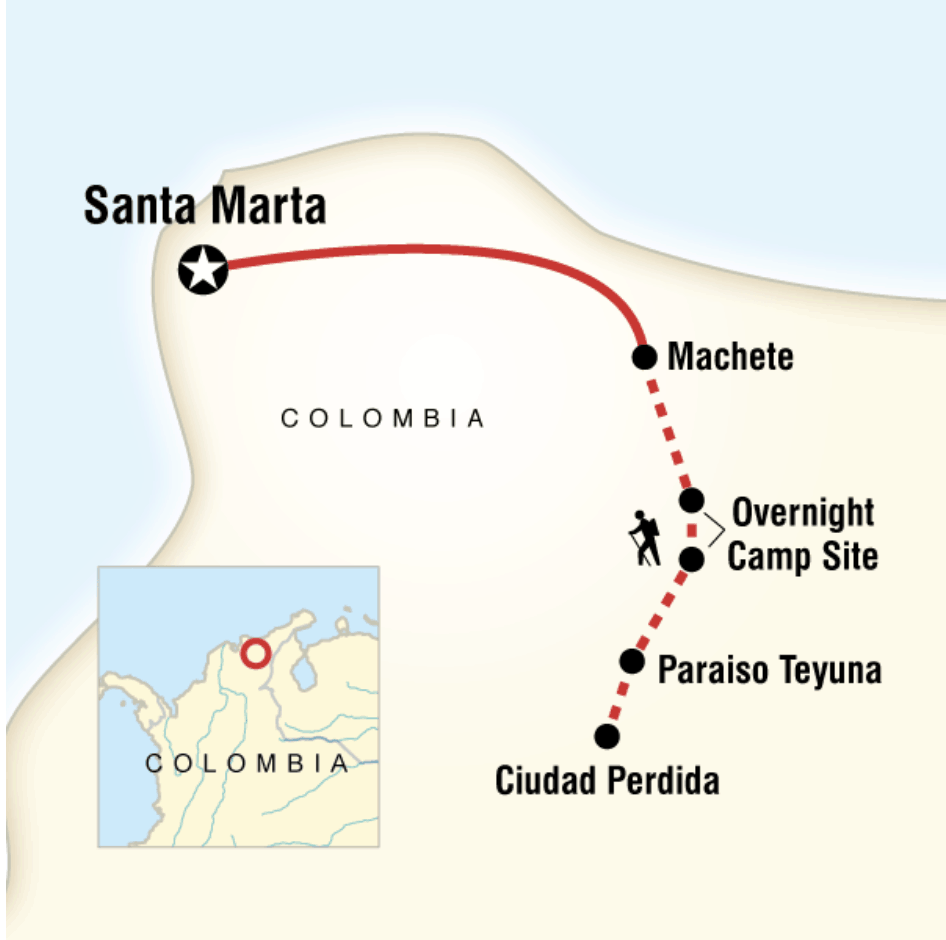
Map of Colombia Lost City Trek – The Route With G Adventures
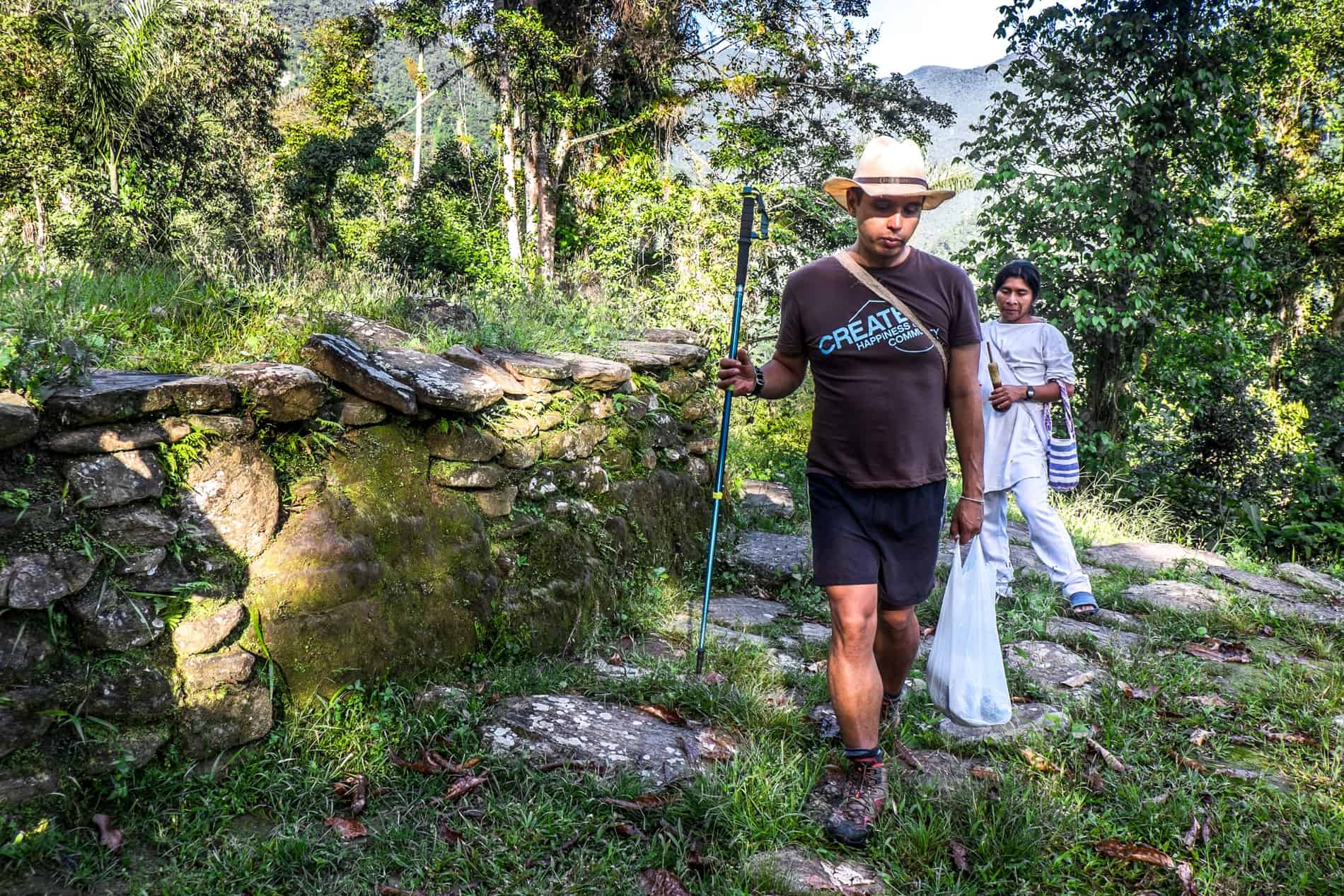
Our G Adventures and Wiwa trekking guides for the Lost City Trek.
My Wiwa guide, Gabo, said it is special when groups go with an indigenous guide and that it is a real experience.
It’s also good to note that many treks are offered in Spanish only, so check if the tour has an English-speaking guide or a translator who will accompany you. Otherwise, you will miss a lot of history and vital information.
How Much Does it Cost to Do the Lost City Trek?
You can expect to pay in the region of $300 for the basic four-day trek package and from $600+ for packages up to six days, including accommodation in Santa Marta. Usually, the same price applies for four, five or six days with the same company.
My Lost City Trek cost around $700 for the seven-day round-trip package outlined above, including the fifth-day trekking route not open to any other trekking company.
In this case, you pay a little extra for the unique experience and know your money is being put back into the community.
What is included in the trek cost of the Lost City Trek
- Usually, at least one night of accommodation in Santa Marta on either side of the trek, with luggage storage.
- Two-hour jeep ride to and from Santa Marta to start and endpoints of the trekking route (Machete and the Gotsezhi Wiwa indigenous community Village).
- Accommodation for the entire trek (basic camps of bunk beds and hammocks).
- Breakfast, lunch and dinners at the trek camps.
- A licensed and trained trekking guide and an accompanying indigenous guide.
- Permits /entrance for trekking in the Lost City / Sierra Nevada national park area.
What’s not included in the trek cost
- Travel insurance, which you must arrange yourself and ensure it includes emergency rescue.
- International flights/airfare.
- Visa costs for Colombia and the organisation of it.
- General trekking gear such as walking poles, although I was given a stick from the jungle
- Snacks.
- Medication (including altitude sickness tablets).
Staying longer in Santa Marta
If you can, spend some extra time Santa Marta before or after your trek. This underrated Caribbean coastal city is also a great base from which to visit the nature reserve of Tayrona National Park. Check out these hotels and hostels in Santa Marta with access to the beach and historical landmarks.
Best Time to Trek in the Lost City
Ciudad Perdida treks run all year round, but seasons can affect the terrain.
When is the Lost City Trek Trail Closed?
The National Park is also closed every September for preservation and maintenance when the indigenous communities perform ceremonies and offer payment to restore the balance of energy.
They say this mountain is the ‘heart of the world’ for them and that when the balance of this place breaks, the whole world will break. They used to close the National Park for two weeks, but since Hurricane Matthew in 2016, which also hit the area hard, they saw it as a warning and now close it for the entire month to balance the bad energies visitors bring in.

The dense jungle of Sierra Nevada that you will pass through on the trek route.
Hiking in Colombia – Lost City Trekking Seasons
In the wet season (March to November) the trails can be more slippery and treacherous, and Buritaca River waters will rise, making the crossings a little trickier. There are ropes at some crossings, but in other parts, you may have to wade through with water at knee or waist height. There is also the possibility of late afternoon and evening torrential rainfall, although this is cathartic when you are cosied up in your camp.
In the dry season (December to March) there is less rain, making the Buritaca River crossings easier where you don’t have to take your shoes and socks off and walk over rocks with a light trickle of water flow. The dry season also sees the biggest flow of visitors, although this isn’t a trekking trail that is overrun. Groups are few and staggered, you rarely pass more than two to four people at a time, and often you feel as if you have the entire trail to yourself.
We trekked in June when the days were hot, and heavy rainfall came almost every afternoon from 4 pm. We counteracted this by always leaving at 5:30 am or 6:30 am to arrive at our next camp station before being caught in the downpour. Your trekking guide will know the weather and formulate a strategy. River crossings were deep and had to be tackled slowly to keep balance in the flowing waters, but in the end, they are fun, and you soon dry off in the heat.

River crossed on the way to Ciudad Perdida.
Lost City Trekking Route – Snapshot
An Indigenous guide and an English-speaking guide will accompany you the entire trip. The Lost City Trek Itinerary looks like this:
Day 1. Santa Marta. Transfer to Machete / Overnight in Wiwa Camp.
Day 2. Trek en route to Teyuna Paraiso Camp.
Day 3. Early climb up to the Lost City Leave / Overnight in Wiwa Camp.
Day 4. Trek back through the jungle, past Kogui communities en route to Ricardito Camp.
Day 5. The exclusive extra-day trek route to reach the Gotsezhi Wiwa indigenous community Village/ Transfer back to Santa Marta.
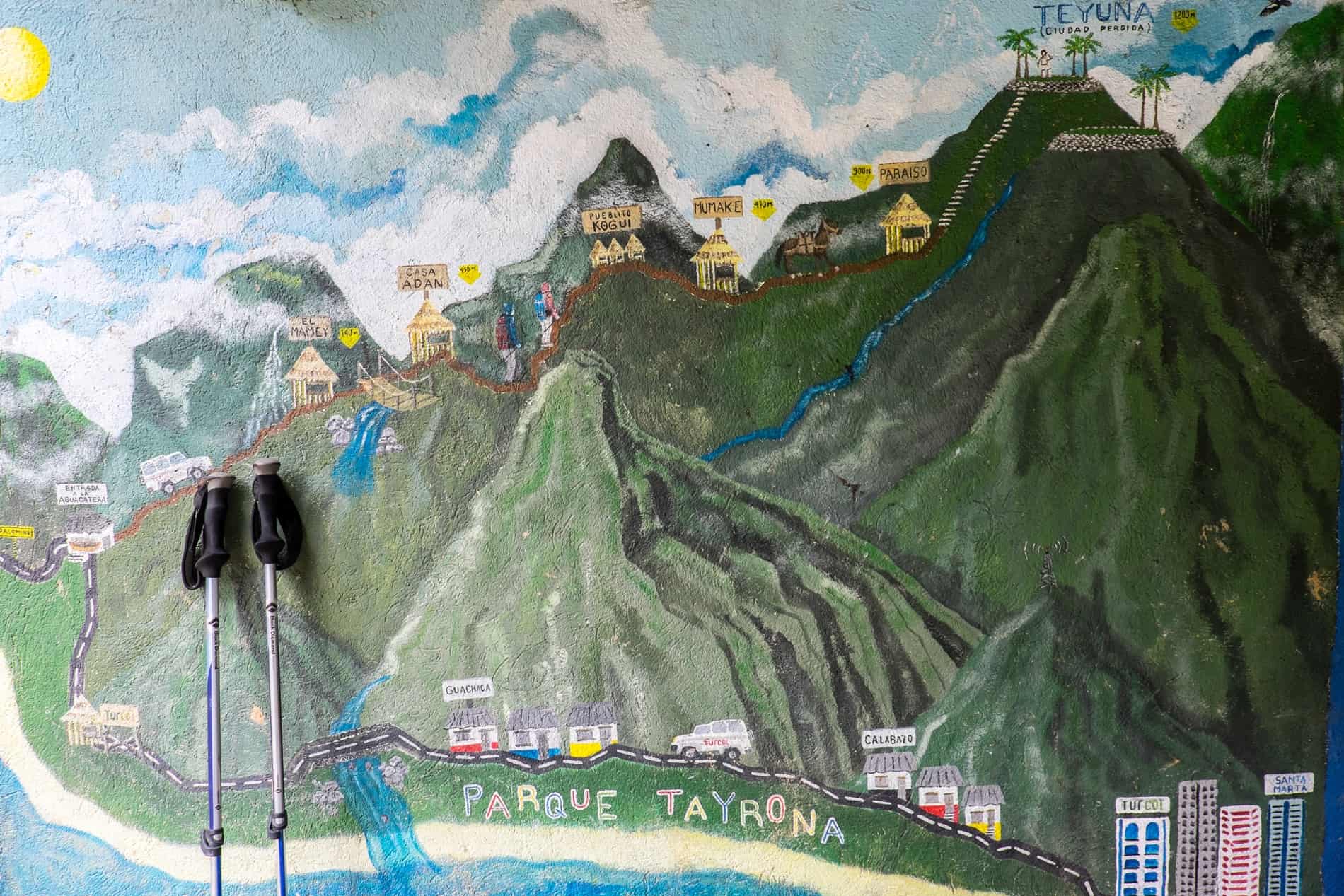
Map of Lost City Ciudad Perdida, Colombia
Is the Lost City Trek Difficult?
Trekking to the Ciudad Perdida (Lost City) is considered a high-difficulty excursion, requiring high stamina levels for steep uphill climbs and downhill navigation.
The reason this trek isn’t longer than four days there and back is that you are not having to battle with extreme altitude, unlike the set-up with other multi-day treks in mountainous regions like the Everest Base Camp trek or climbing Kilimanjaro, which have a similar distance but strategic rest days for high altitude acclimatisation.
The Lost City sits at an altitude of 1,200 metres (3,937 ft.) above sea level and is the highest point of the trek. No technical equipment such as ropes and harnesses are required, but this is raw, uneven jungle territory with narrow pathways, uneven surfaces, loose rocks and dense foliage in parts.
Two avid trekkers on my trip confessed that the Lost City was more difficult than the Inca Trail, Kilimanjaro and trekking to Everest Base Camp.

A steady incline jungle path through the beautiful Sierra Nevada de Santa Marta.
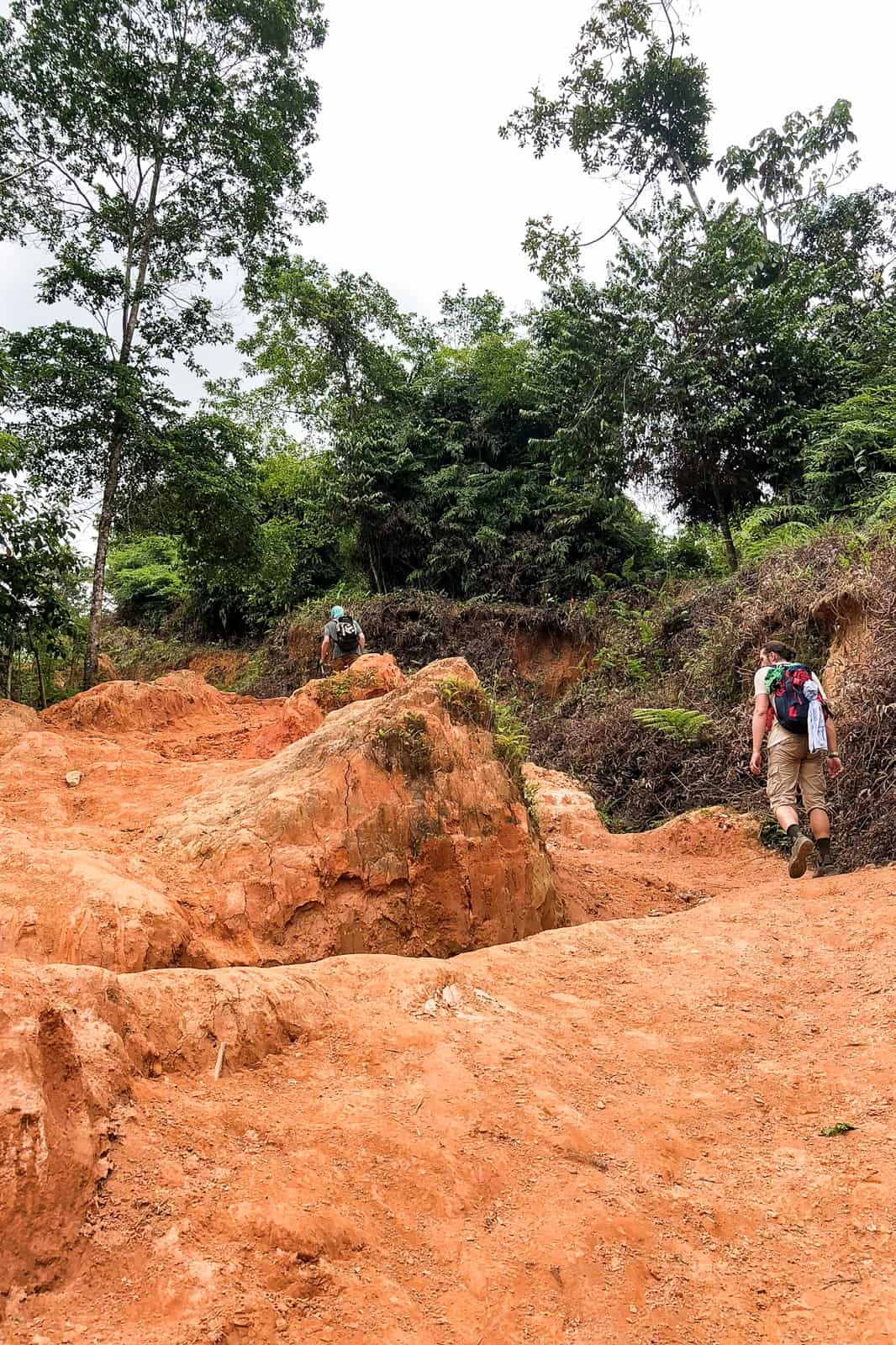
Some of the steeper Lost City climbs on mud paths.

The slow and steady pace of the group. Getting to the Lost City is not a race.
Do I Need to Train for Lost City Trekking?
You need to be in good physical fitness for this trek. If you train regularly in some fitness activity, you will have a good basis for strength and recovery.
If not, I suggest taking on some smaller day hikes before this trip, where uphill and downhill terrains can be trained to not only get used to four to six-hour trekking times but also to get used your body used to the tricky terrain.

Sweat and smiles. High fitness levels are needed for Lost City Ciudad Perdida trek.
What to Pack for Lost City Trekking
You must pack as little as possible for the Lost City trek since you will carry your backpack the entire time. This includes carrying a litre bottle or two of water alongside clothing, swimwear, toiletries and electronics.
It’s not hard; you just have to pack precisely and minimally.
READ MORE: Lost City Trek Packing List – Preparing for a Jungle Adventure.
Lost City Trek Day-by-Day
Every day is different hiking the Lost City, but here’s what you can expect to encounter and what to prepare for.
DAY 1. Starting the Lost City Trek
Elevation: Started at 340m – climbed to 650m. Slept at 400m at Wiwa campsite
Trekking Time: 7 Hours (with two rest stops)
We left Santa Marta at sunrise for a two-hour jeep journey to the trek starting point at Machete, where we had breakfast. 95 families live in this area, given the name Machete from its former era of violence from narco cartels, guerillas and paramilitary who dominated this area for coca production.

Day one of the Lost City Trek, leaving lowland villages and working our way up into the peaks.
We start walking at 8 am, stopping after a couple of hours at a rest stop set up by a guy whose income rests on squeezing fresh orange for weary, already sweaty trekkers. This trail continues, leaving the farmland and entering the terrain of indigenous villages where around 80 families, mainly Kogui and Wiwa, reside.

The fresh orange juice rest stops along the way.

Dense Jungle tracks make up much of the Lost City trail.

Donkey mules between the Lost City camps.

Passing an Indigenous house on the trekking trail.
Day one is broken down into three hours of back-to-back climbing and descending before stopping for lunch (at the Ricardito Camp, where we will sleep on the night of Day 4) before continuing on another three to four-hour stretch of more downhill, even steeper uphill, before the last downhill to the Wiwa campsite.

The Wiwa campsite on the Lost City trek, with basic facilities.
This consistent up and down is brutal in parts, but the scenery eases the pain, as does always reminding yourself what the end goal is.
DAY 2. The Long Walk to Lost City Base Camp
Elevation: Started at 400m and walked to 800m.
Trekking Time: 5.5 – 6 Hours (with two rest stops)
A 6.30 am start for an overall six-hour trek to the Paraiso Teyuna campsite, with two small resting stops in between. This is the camp closest to the Lost City, a form of Base Camp where everyone rests before the ascent to the Ciudad Perdida.
You first pass a Kogui village. A community of semi-nomadic people and farmers, they don’t live in these villages and only come back to them sporadically. The structures are symbolically built, with two stumps on the top of each house representing the two sacred peaks of the Sierra Nevada mountain which are the highest points and closest spiritually. The walls represent the earth.

Indigenous Kogui village in the Sierra Nevada de Santa Marta.

Crossing a river bridge.
This is another day of arduous uphill climbs on rocky pathways, protruding tree roots, and through small parts of dense jungle and thick forest. You know you are getting more into the heart of the jungle on this day as the thick vegetation scenery is similar to the varied landscapes on the first day that changed from farmland to the tropics.
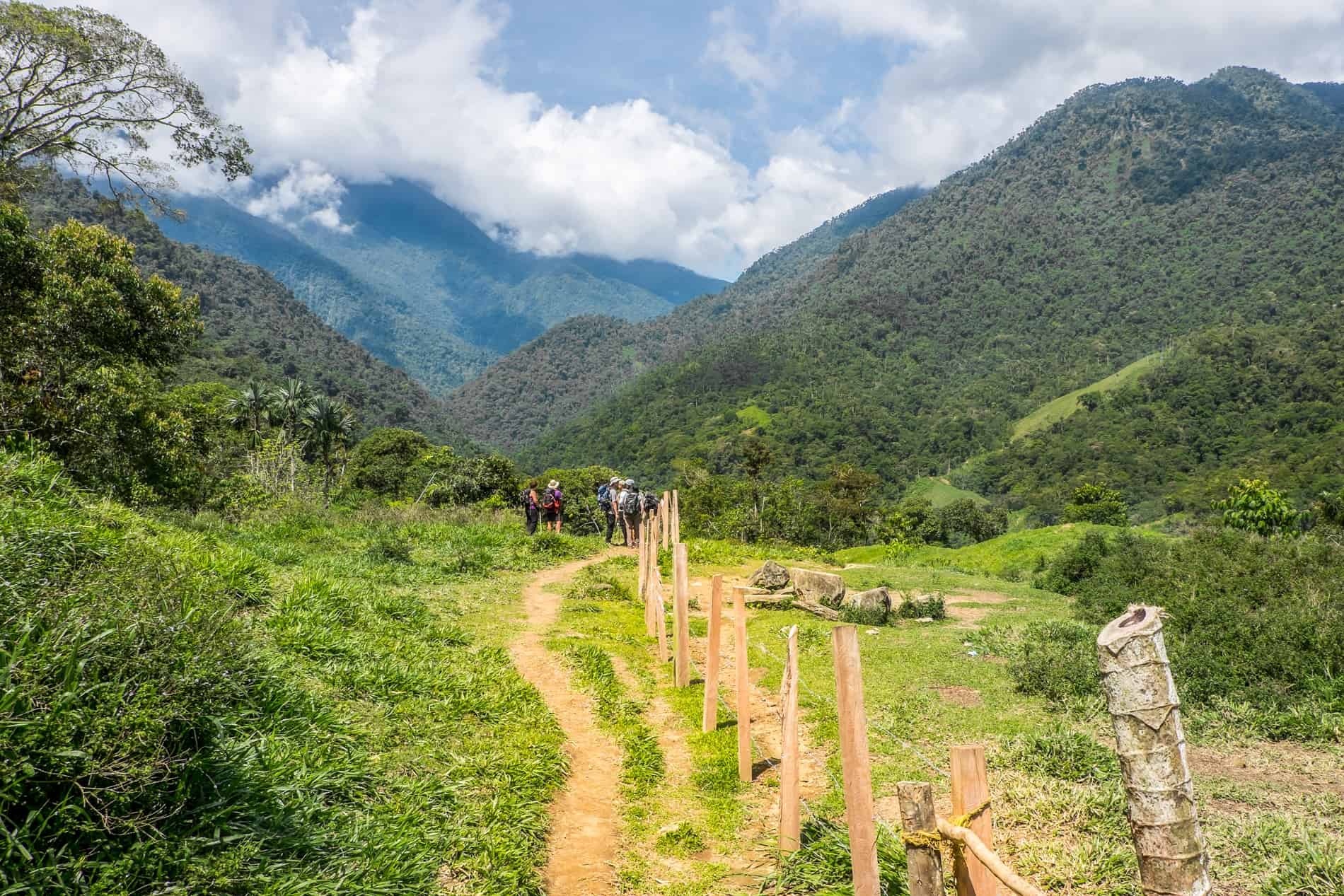
Trekking through forested hills.

Thick, tropical green on Day 2 of the Lost City Trek.

Getting into the thick of the jungle.
It’s also the day you will tackle one of the river crossings before navigating an ‘Indiana Jones’ style patch of jungle with steep rocks to climb to get onto the trail leading to camp. It felt exciting, raw, untouched, and secret. A feeling in the run-up to what is coming.

The Paraiso Teyuna campsite – The Lost City Base Camp.
DAY 3. Arriving at the Lost City.
Elevation: 1,500m at Lost City, before trekking back down to 400m at Wiwa campsite
Trekking Time: 6-7 Hours
Since the Paraiso Teyuna campsite is busy, and usually with around 100 people resting there at a time, groups are staggered in when they leave for the Lost City.
At 5.30 am, we were the first to leave. It took one hour on a short jungle walk and river crossing before reaching the 1,200 narrow, steep, uneven stairs that climb up into the entrance to the Lost City.

The steep start of the 1,200 stairs to the Lost City.
The overgrown nature that hugs the site gives you a feeling that you are the first to arrive and find the site. With our Wiwa guide, we walked silently in a circle and then stood with our eyes closed before putting a leaf in the middle of the circle. It’s a form of offering to nature and the spirits who live here, announcing a person’s presence.
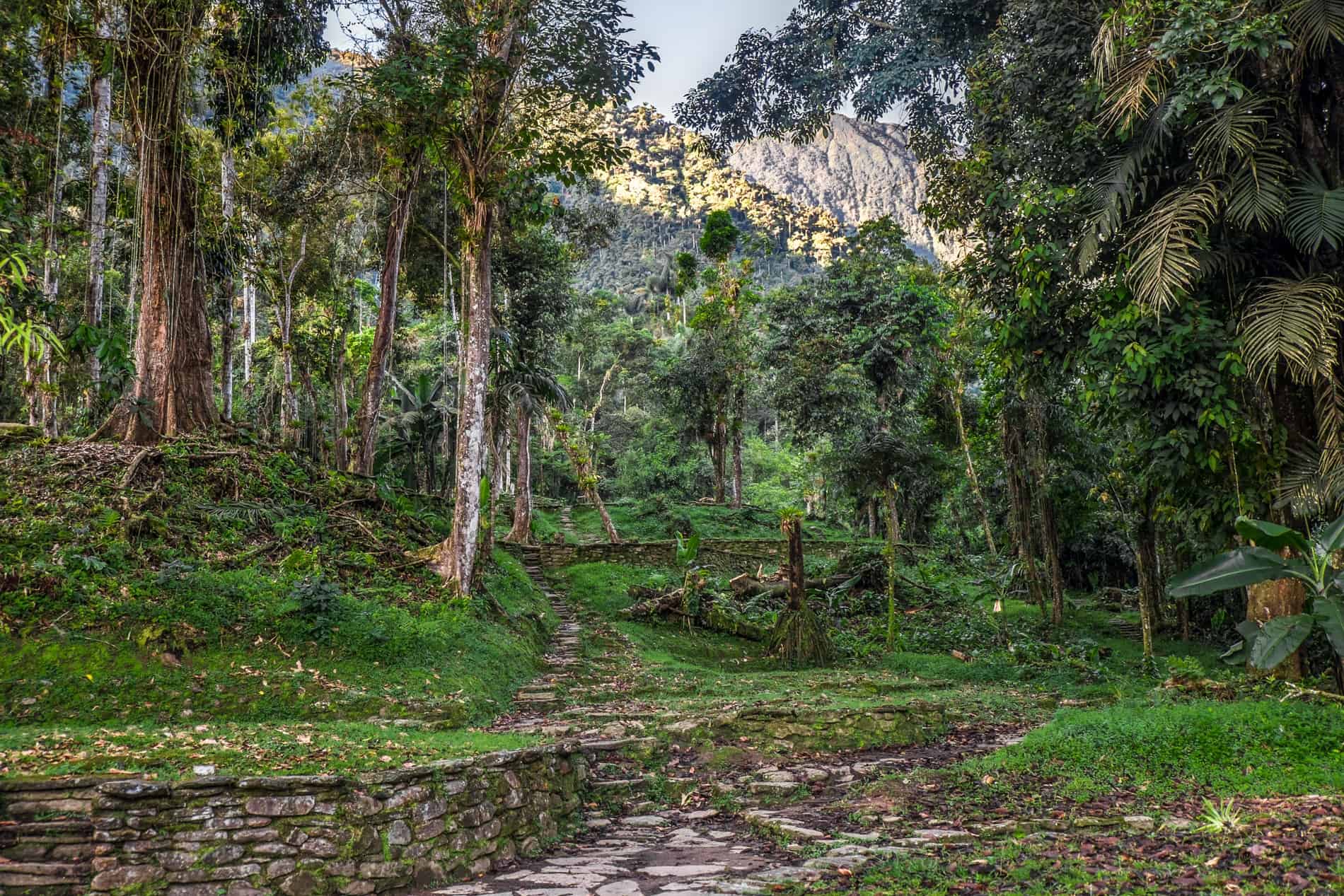
The archaeological site of la Ciudad Perdida is said to be only 10% uncovered.

Viewing the ancient rock map of Ciudad Perdida.

Gabo resting on the stone ruins of the Lost City site.
We wandered around small stone circles of former market and meeting places, ruins of drainage systems and agricultural structures before another stone trail took us up to the ‘Central Axis’. Here was where the main houses and temples once stood, now a site of large, stacked stone terraces that you clamber up and climb before turning around for the once-in-a-lifetime magnificent view over the Lost City.

The stone pathway to the elevated view of the Lost City terraces.

Magnificence. La Ciudad Perdida (Lost City) is one of the most important cities in Colombia.

The mountain top vastness of the hidden city.

Jungle-covered stone terraces of Ciudad Perdida (Lost City). There’s said to be more buried within here waiting to be uncovered.
You must take the same steep stone stairway back down, which requires slow and precise movement. It’s time for breakfast at camp before leaving at 9 am for a four-hour trek back to the Wiwa Camp (from Day 2). You can ease those aching muscles swimming in the lake next to the Wiwa camp.
DAY 4. Leaving the Lost City Trail.
Elevation: Climbing back up to 700m
Trekking Time: 3 hours
We started the morning with a natural cleanse in the waterfall near our camp before continuing back on the same track we took on the first day. This is the day when you effectively leave the Lost City trekking trail. It took three hours, with an additional one-hour rest and a last steep uphill 30-minute stretch to the Ricardito Camp, where we had lunch on the first day. We rested, had dinner and slept here.

Easing aching muscles at the lake waterfall.

Overnight at Ricardito Camp.
This was also the chance to spend a restful few hours with our Wiwa guide, Gabo, where we could ask him questions about his culture and the rise of interest in the trek to the lost city.
Day 5. Exclusive Trekking Excursion to Wiwa Community.
Trekking Time: 5 – 6 hours
Despite knowing there was another trekking day ahead of us when we were already exhausted, we knew this final day was special. Leaving at 6 am, it was a two-hour steep climb into some farmland and another two hours wading through some deep, untouched jungle.

Hiking in Colombia and the Sierra Nevada is considered one of the best treks in South America.
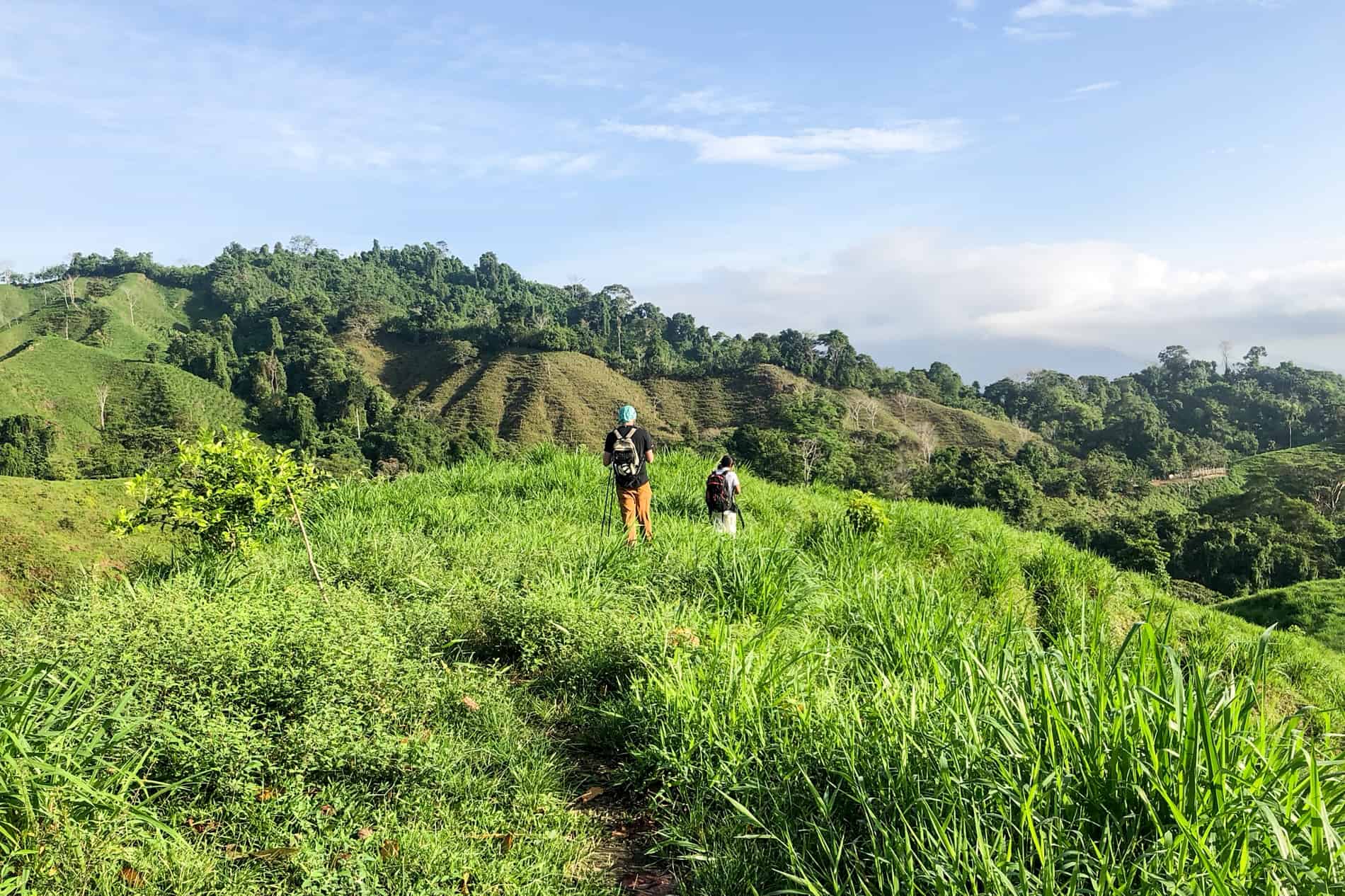
Getting off track on the extra Lost City trek day, crossing hilltop farmland.

Dense green hilltop forests in the Sierra Nevada de Santa Marta National Park.

Taking a break at a local house.

Stretches of rugged terrain.

Last stretches of deep jungle trekking.
One last river crossing brings you to the heart of the Wiwa village, made even more special because it was the home of our Wiwa guide, Gabo, who helped lead our entire journey.
We were met by a Mamo (the spiritual leader of the community who keeps the natural order), who blessed us and tied a white ribbon around each of our wrists, marking a rather emotional end to these arduous days.

Meeting the Mamo of the Wiwa Village.

Receiving a blessing from the Mamo after completing the Lost City Trek.
The Wiwa community of Gotsezhi is the location of the first G Adventures Planeterra project in Colombia. It started in early 2017, with Planaterra offering funding and consultancy on a social impact project that is fully owned by the Wiwa community.
The introduction of tourism to this once isolated community allows both for the education of travellers about the indigenous way of life, and for these people to continue to reclaim their land that was once lost or displaced due to the illegal activity in the mountains from the growth of coca plantations for cocaine production.

The Wiwa community of Gotsezhi.

Demonstration on how to make rope from plants.

Basket weaving at the Wiwa Village.
The project brings benefits and opportunities outside of the trekking corridor, which only benefits people on the trek. Women have been provided with new means of income in the fields of cooking, hospitality and weaving and the men are trained for jobs things like leading the Lost City trek.
With this comes a feeling of empowerment and pride that outsiders want to visit the Wiwa people and better understand them and their culture.
Some of the cooks here will become cooks on the trek and one day, maybe we will even see female guides lead the way on this sacred pilgrimage.
It is here that G travellers enjoy their last lunch together at the restaurant that has been established here as part of the project before the two-hour jeep ride back to Santa Marta.
Is The Lost City Trek Worth It?
The Lost City trek is one of the most brutal, treacherous, and hardest treks I have ever undertaken in one of the most beautiful patches of earth.
But while the Lost City has never truly been lost, with Tayrona descendants having always known of its existence under the covering of foliage that kept it hidden from the outside world, we should be grateful we are given the opportunity to witness it, knowing that the pain and glory of getting there on foot adds greater weight to its meaning.
Any plagiarism of this Lost City Trek guide or any of its descriptions and images used on other sites and blogs without attribution is not information authorised by myself for use. Know your source.




Agata Kotkowska says
Hello,
As you have written it was amost brutal trek I just want to double check with you whether there is any possibility for a family version of a trek? We have 2 teenagers 16 and 14 and I am wondering whether there is a poasibility to rent a horse for my daughter who might not be able to walk so long and taugh distances. Maybe it is only for fit adults?
Thank you for your response,
kind regards
Agata
Becki says
Hi Agata. There isn’t other versions of the trek – everyone takes the same path, with the same difficulty. I wouldn’t recommend taking a horse most of the way, as they are not meant for that. They carry supplies, and are used by by trekkers in emergences, mostly. I would however, once choosing your trekking company, to liaise with them about how to go about it with kids.